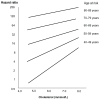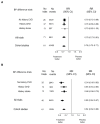Proof of concept in cardiovascular risk: the paradoxical findings in blood pressure and lipid abnormalities
- PMID: 22870036
- PMCID: PMC3411330
- DOI: 10.2147/VHRM.S32585
Proof of concept in cardiovascular risk: the paradoxical findings in blood pressure and lipid abnormalities
Abstract
High blood pressure and lipoprotein abnormalities were identified by many cohort studies as the major risk factors for cardiovascular disease. Laboratory experiments apparently confirmed their role in the causation of atherosclerosis, but a proof of concept requires the corroboration by clinical trials in human beings. The size of benefit in clinical trials regarding the control of high blood pressure was within the estimations of risk provided by cohort studies. For a reduction of 10 mmHg in systolic blood pressure or 5 mmHg in diastolic blood pressure, the relative risk reduction of coronary heart disease was 22% (95% confidence interval 27%-17%) in a meta-analysis of clinical trials, close to the estimation of reduction of 25% (95% confidence interval 23%-27%) provided by a meta-analysis of cohort studies. The corresponding values for stroke were 41% (95% confidence interval 33%-48%) in clinical trials compared to a cohort risk prediction of 36% (95% confidence interval 34%-38%). This efficacy was shared by all blood pressure-lowering drugs. The same figure has not paradoxically happened with drugs that act over abnormalities of cholesterol and lipoproteins. Only statins, which have other beneficial actions as well, have consistently lowered the incidence of cardiovascular diseases, an efficacy that was not reproduced by older and newer quite potent lipid drugs. The adverse effects of these drugs may nullify their beneficial effects over lipoproteins and abnormalities of lipoproteins may only be surrogate markers of the underlying real risks.
Keywords: clinical trials; hypertension; lipoproteins; proof of concept.
Figures



References
-
- Lewington S, Clarke R, Qizilbash N, Peto R, Collins R. Age-specific relevance of usual blood pressure to vascular mortality: a meta-analysis of individual data for one million adults in 61 prospective studies. Lancet. 2002;360(9349):1903–1913. - PubMed
-
- Lewington S, Whitlock G, Clarke R, et al. Prospective Studies Collaboration. Blood cholesterol and vascular mortality by age, sex, and blood pressure: a meta-analysis of individual data from 61 prospective studies with 55,000 vascular deaths. Lancet. 2007;370(9602):1829–1839. - PubMed
-
- Grady D, Herrington D, Bittner V, et al. Cardiovascular disease outcomes during 6.8 years of hormone therapy: Heart and Estrogen/progestin Replacement study follow-up (HERS II) JAMA. 2002;288(1):49–57. - PubMed
-
- Rossouw JE, Anderson GL, Prentice RL, et al. Risks and benefits of estrogen plus progestin in healthy postmenopausal women: principal results from the Women’s Health Initiative randomized controlled trial. JAMA. 2002;288(3):321–333. - PubMed
Publication types
MeSH terms
Substances
LinkOut - more resources
Full Text Sources
Medical

